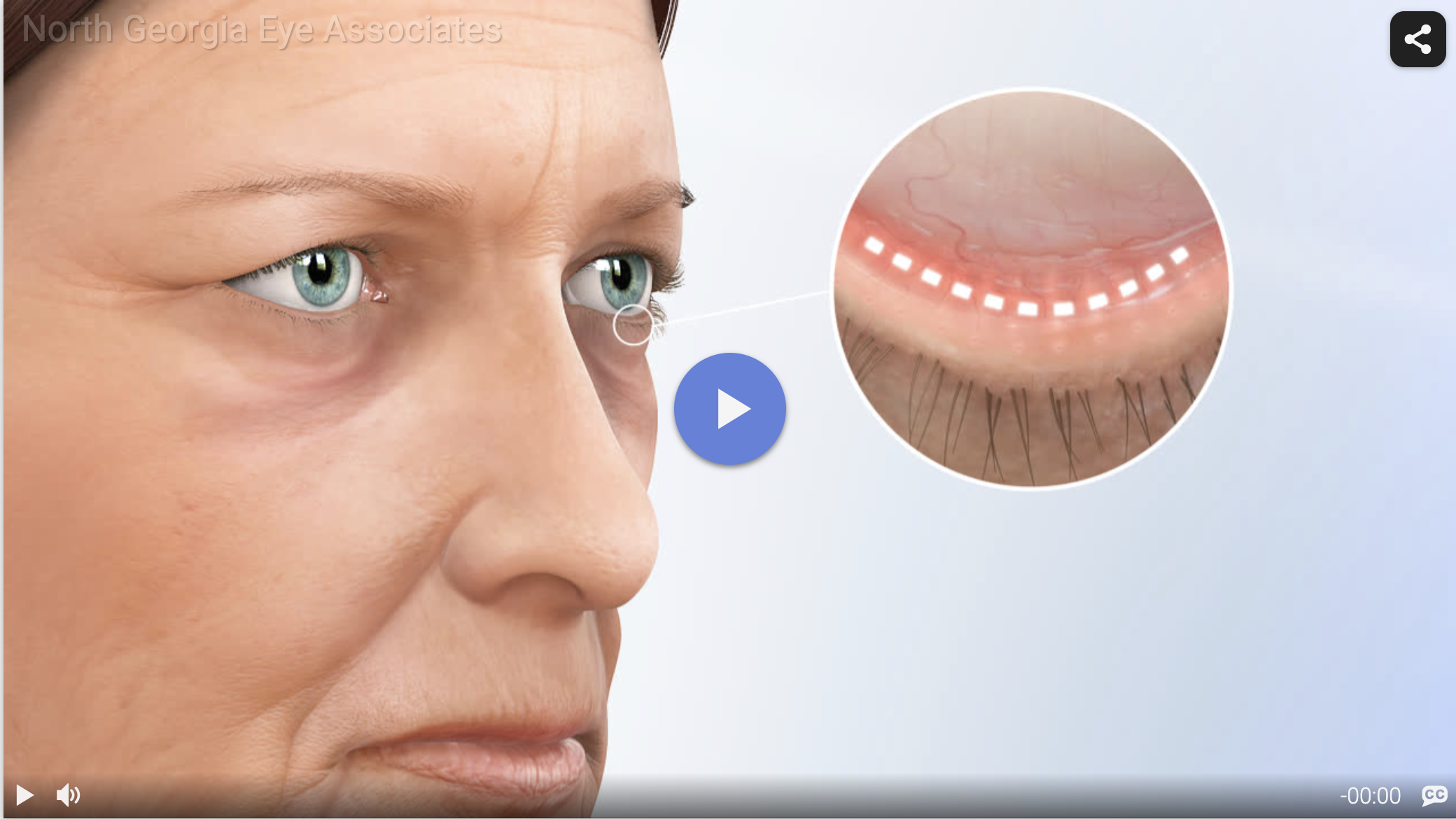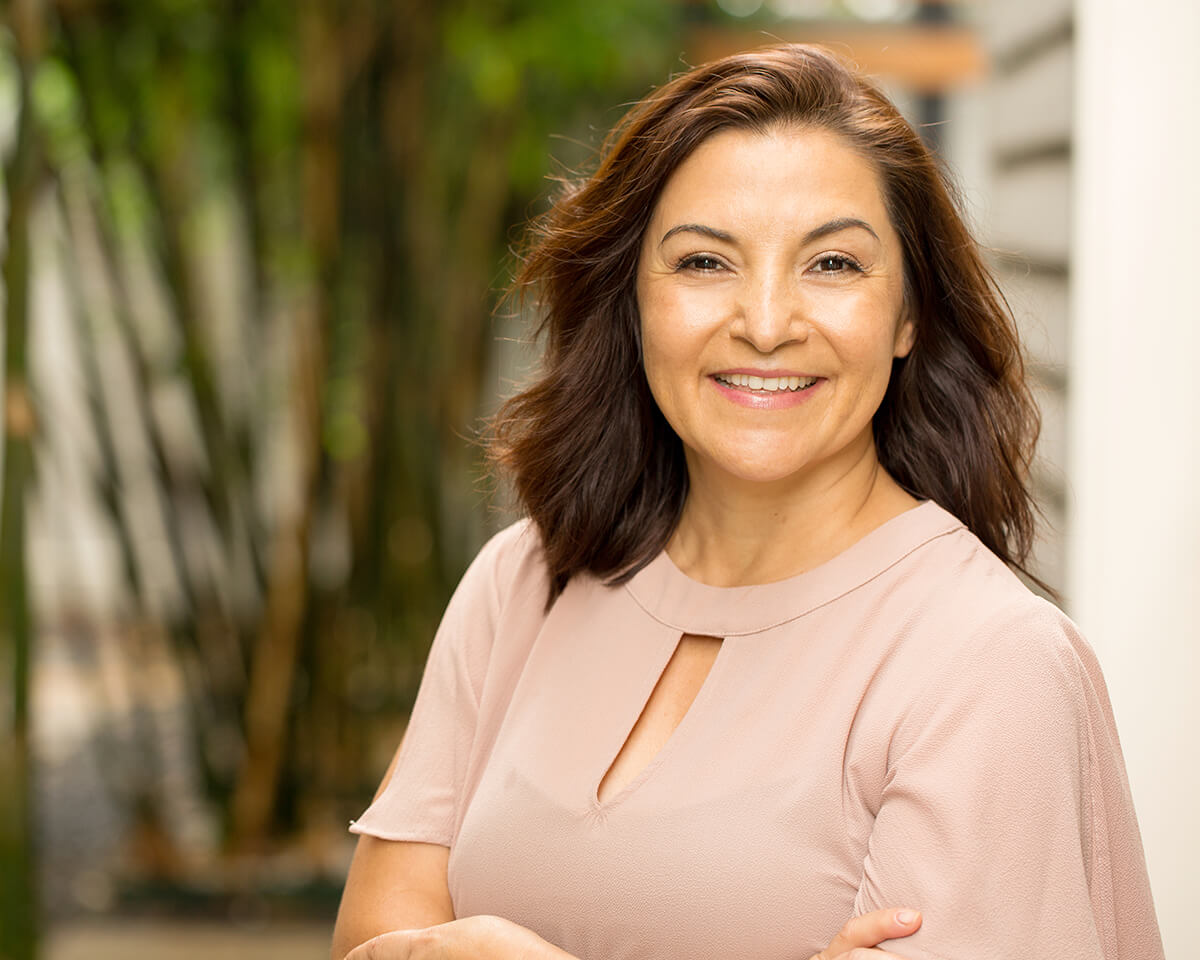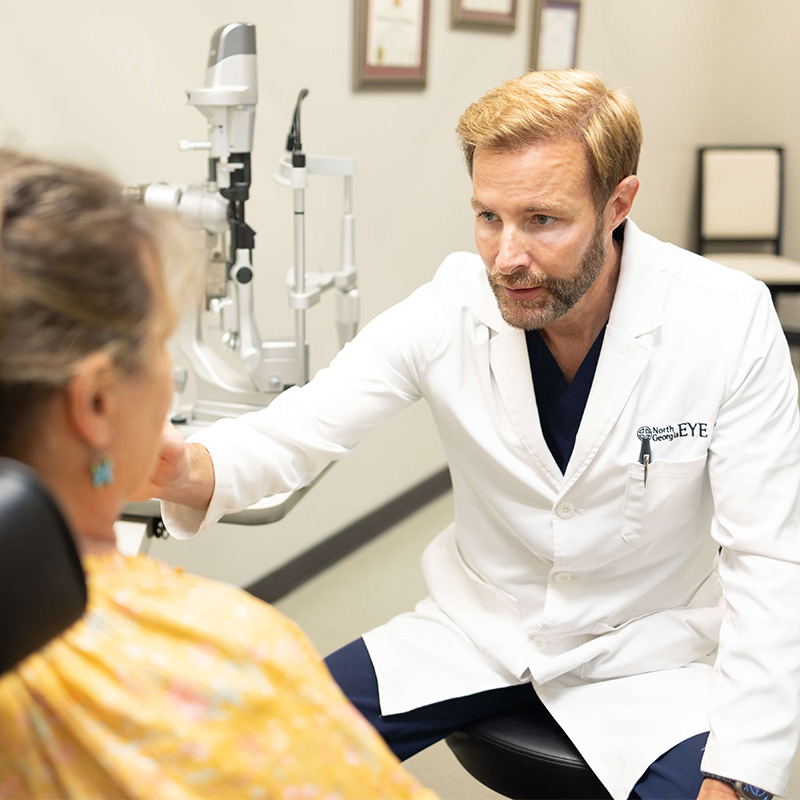Surgical & Non-Surgical
Procedures at North Georgia Eye Associates
North Georgia Eye Associates provides a variety of surgical and non-surgical solutions to help you
achieve a youthful appearance. Explore our treatment options such as Mohs reconstruction, BOTOX,
fillers, eyelid cancer treatments, and more. Additionally, our board-certified oculoplastic surgeon,
Dr. Brent Hayek, is available to advise on the best procedure for you.
Eyelid Solutions
Blepharoplasty
Blepharoplasty, or eyelid surgery, is often performed for cosmetic reasons. With age, it becomes more
common to experience droopy or saggy eyelids.
But undergoing blepharoplasty can also be performed out of medical necessity. Having droopy eyelids may
reduce your peripheral vision, making seeing more challenging.
Lower Blepharoplasty
During lower blepharoplasty, you’ll have any extra tissue and undereye bags removed while improving
the contour of your eyelid. The incision is placed below the lash line to remove any excess skin,
and then Dr. Hayek will lift the skin, creating a more flattering and aesthetically pleasing
look.
Upper Blepharoplasty
Upper blepharoplasty involves undergoing eyelid surgery on your upper eyelids. With upper
blepharoplasty, you’ll have any excess fat and skin removed that falls over the eye’s natural
crease.
Find Out if a Blepharoplasty Procedure is Right For You
Take the Self Test
Meet Your Oculoplastic Surgeon
Dr. Brent Hayek
Dr. Brent Hayek, MD, is a highly skilled oculoplastic and reconstructive surgeon. With an
illustrious background, Dr. Hayek previously held the position of Associate Professor in Oculoplastic and
Reconstructive Surgery at the esteemed Emory University School of Medicine. His peers voted him one of the
Best Doctors of Atlanta in 2023.
With over 15 years of experience, he has specialized in providing exceptional care to adults
and children, focusing on reconstructive and cosmetic procedures for the eyelids, face, orbit, and tear
drainage system. Dr. Hayek’s academic journey has been impressive, graduating summa cum laude from Oral
Roberts University and working as an analytical chemist for five years.
He pursued his medical education at the University of Iowa School of Medicine, graduating
with honors from the Alpha Omega Alpha (AOA) honor society. His medical training continued with an
internship in General Surgery and a residency in Ophthalmology at Loyola School of Medicine in Chicago. To
further refine his expertise, he completed a fellowship in Oculoplastic Surgery at the prestigious UT MD
Anderson Cancer Center in Houston.
Want to learn more about our Cosmetic options?
Common Eyelid Conditions
Entropion

Entropion is a condition that occurs when your eyelid turns in toward your
eye. When this happens, it causes your eyelashes and skin to rub against
your eyeball, causing discomfort to the cornea.
Entropion is commonly seen in adults 60 and older, and Dr. Hayek may treat it
using Botox, soft contact lenses, or surgery when necessary.
Ectropion

Ectropion is like entropion, except it occurs when the eyelid faces out. The
condition can occur on the upper or lower eyelid but commonly affects the
lower lid.
Ectropion may cause the inside of your eyelid to become irritated. Dr. Hayek
has a variety of methods to treat ectropion, including eye drops or surgery
to remove part of the lid and reattach the ligaments into a tighter position
to help the eyelids fit together better.
Droopy, Puffy Eyelids and Eyebrows
With age, it becomes more common to suffer from droopy, saggy eyelids and
eyebrows. Certain conditions may cause you to look older or more tired than
you are, necessitating an oculoplastic procedure by Dr. Hayek.
Ptosis

Ptosis is a condition that occurs when your upper eyelid droops over your
eye. Ptosis can happen to patients of any age.
Many patients develop ptosis due to aging (acquired ptosis) when the levator
muscle stretches or separates from the eyelid. The most likely causes are
aging or because of an eye injury.
Ptosis may cause the eyelid to droop slightly or result in total pupil
coverage, leading to an inability to see and reducing your field of vision.
Many adult patients with ptosis will undergo surgery to help the eyelid
muscle work better and to improve vision.
Dermatochalasis

Dermatochalasis refers to loose or saggy skin on the eyelids. It often occurs
due to aging and could be most dramatically seen on the upper eyelids.
However, you can also have dermatochalasis affecting the lower eyelids as
well. Dermatochalasis and ptosis differ, as ptosis refers to the levator
muscle stretching or separating from the eyelid rather than baggy or saggy
skin.
Birth Defect

An infrequent cause of eyelid retraction is birth defects or congenital.
Congenital eyelid retraction may involve the upper, lower, or both
eyelids.
Thyroid Eye Disease/Graves’ Disease

Thyroid eye disease is usually associated with Graves’ disease, which is an
autoimmune condition. With Graves’ disease, the thyroid gland becomes
overactive, leading different antibodies to attack the muscles that control
the eye and eyelid movement.
Thyroid eye disease causes bulging eyes, double vision, and eyelid
retraction. In patients with thyroid eye disease, retraction of the eyelids
can be treated using surgery.
Dr. Hayek will move the eyelids into a more normal position to help improve
the feel and appearance of the eyes in thyroid eye disease patients.
Eyelid Trauma

Dr. Hayek can treat eyelid trauma due to things like cuts and lacerations,
bruises and contusions, orbital fractures, burns to the eyelid, if a foreign
body becomes lodged in the eyelid or under the eyelid’s skin, abrasions to
the eyelid, bites or stings, allergic reactions, and surgical complications.
How eyelid trauma is treated will depend on the severity of the trauma and
the type of injury.
Orbital Disorders
Orbital disorders are conditions that affect the orbit of the eye. The orbit is the socket that houses the eye
and its structures.
Orbital disorders can be benign or more severe and may impact your vision, eye movement, and the health of your
eyes. Common orbital disorders include orbital cellulitis, orbital fractures, thyroid eye disease, orbital
tumors, orbital inflammation, and orbital myositis.
Orbital Tumors

An orbital tumor is an abnormal growth or mass that develops within the
orbit. Orbital tumors can be benign or cancerous. They can grow in various
tissues of the orbit, including the eye, its surrounding muscles, blood
vessels, connective tissues, and nerves.
If you have an orbital tumor, you may experience several symptoms like
bulging of the eye, swelling and redness of the eye, eye pain, reduced eye
movement, or changes to the appearance of your eye, among others, which may
require treatment.
Orbital Trauma

Orbital trauma is an injury or damage to the structures within the orbit and
its tissues. You can suffer orbital trauma for reasons like an accident,
falling, an injury from playing sports, or any other incidents that may lead
to the eye and its surrounding structures becoming impacted.
You can suffer mild to severe orbital trauma, which can have a significant
effect on your vision, ability to move your eyes, and the health of your
eyes.
Tear Duct Obstruction

Tear duct obstruction, also called a blocked tear duct or nasolacrimal duct
obstruction, occurs when the tear drainage system becomes partially or fully
blocked. Tears cannot drain properly from the eye’s surface into the nose
when this happens.
Tears should flow from the surface of the eye through the puncta and into the
nasolacrimal duct. The nasolacrimal duct carries tears into the nasal
cavity. If this drainage system becomes obstructed, tears cannot flow as
they should, leading to problems like irritation, excess tearing, and other
complications. Treating tear duct obstruction may require surgical
procedures like dacryocystorhinostomy (DCR) to create a new drainage pathway
for tears to bypass the obstructed duct.
Dermatochalasis

Dermatochalasis refers to loose or saggy skin on the eyelids. It often occurs
due to aging and could be most dramatically seen on the upper eyelids.
However, you can also have dermatochalasis affecting the lower eyelids as
well. Dermatochalasis and ptosis differ, as ptosis refers to the levator
muscle stretching or separating from the eyelid rather than baggy or saggy
skin.
Anophthalmia Socket/Artificial Eyes

Anophthalmia refers to a person born without one or both eyes. This can
happen because the eyes don’t grow as they should while a baby is in the
womb.
As a result, they may not have one or both eyes, leaving a space where the
eye or eyes should be. If this happens, they can have an artificial eye or
prosthetic eye, which is custom-made to comfortably fit within the eye
socket and designed to match the appearance, color, and size of the
remaining eye.





